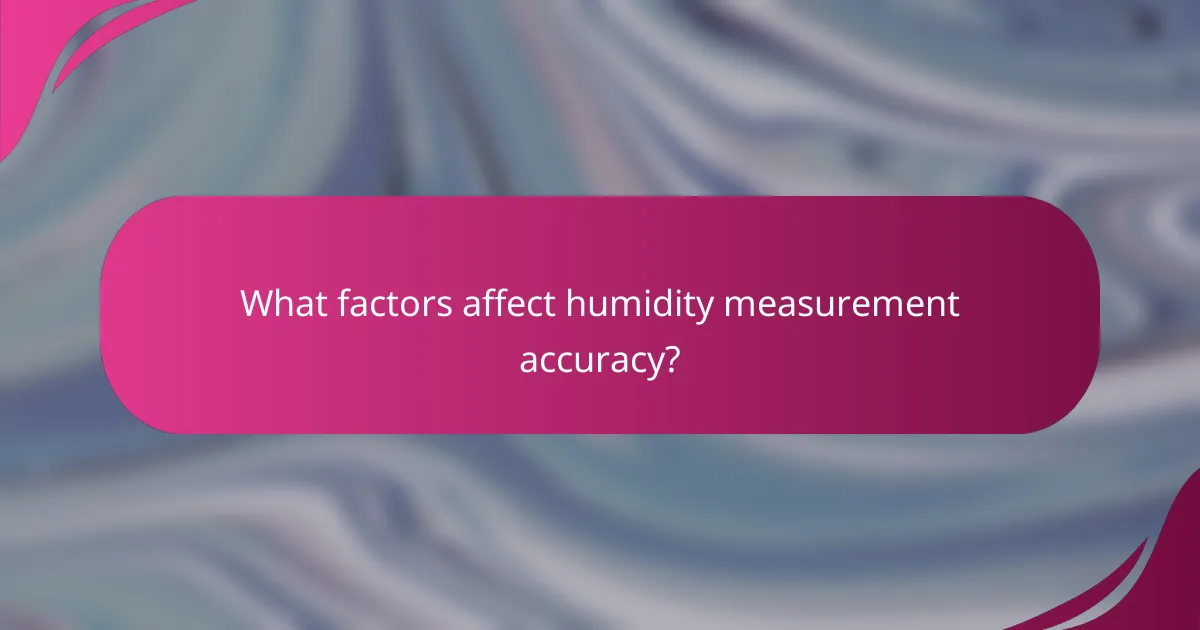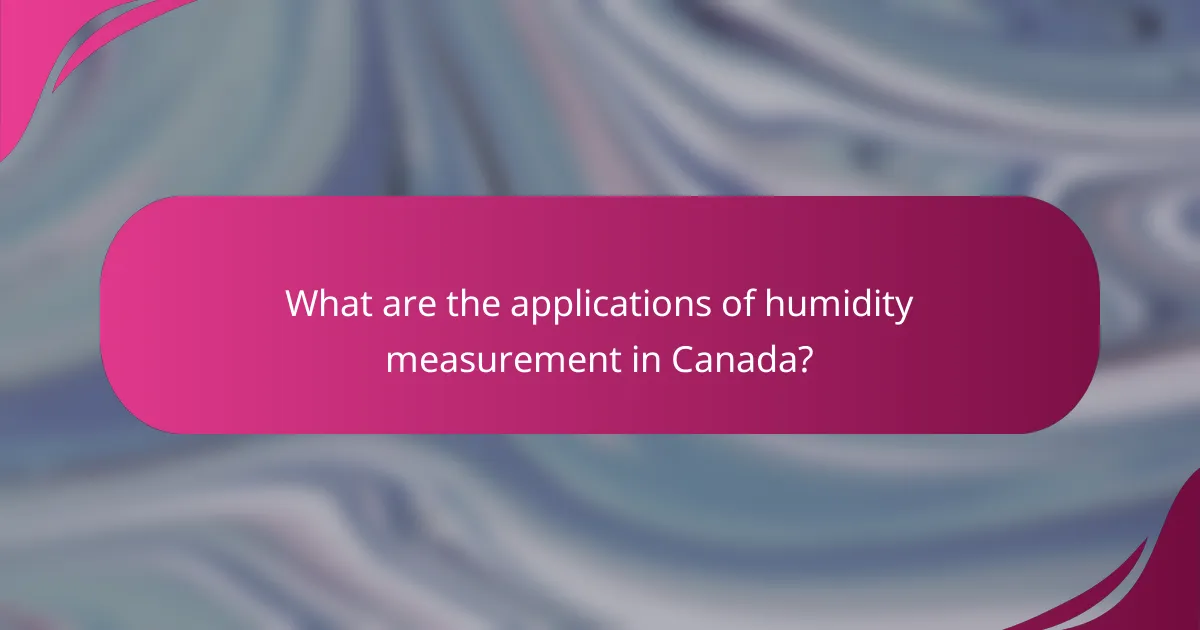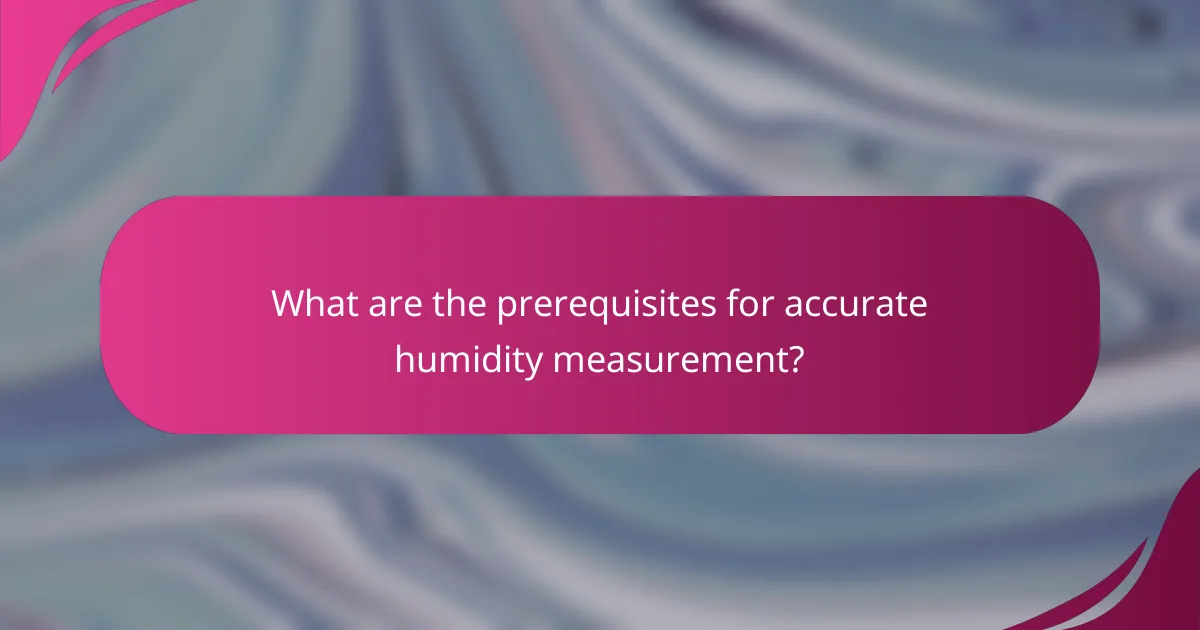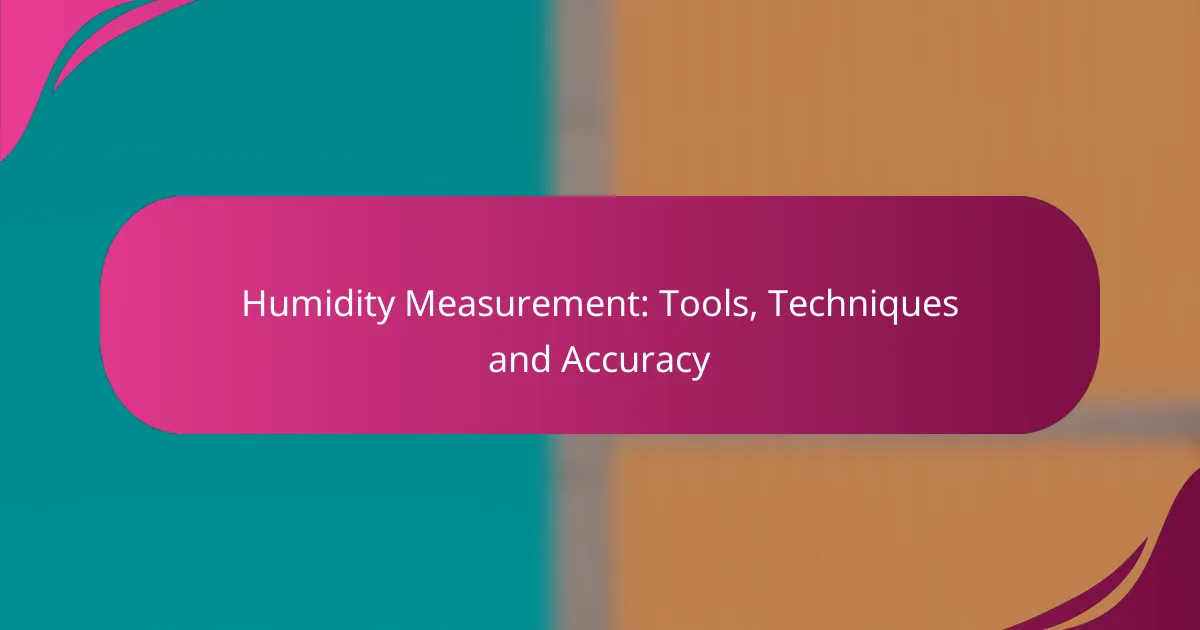Humidity measurement is essential for various applications, from home comfort to industrial processes. A range of tools, including hygrometers and data loggers, offer different levels of accuracy and features tailored to specific needs. The choice of measurement technique and understanding factors affecting accuracy are vital for obtaining reliable humidity readings.

What are the best tools for humidity measurement in Canada?
The best tools for humidity measurement in Canada include hygrometers, dew point meters, data loggers, smart home sensors, and portable humidity meters. Each tool offers unique features and levels of accuracy, making them suitable for various applications such as home use, industrial settings, or environmental monitoring.
Hygrometers
Hygrometers are the most common instruments for measuring humidity levels. They can be analog or digital, with analog models often using a dial to indicate relative humidity, while digital versions provide precise readings. When selecting a hygrometer, consider the range of humidity it measures, typically from around 0% to 100%, and its accuracy, which can vary by brand and model.
For home use, a digital hygrometer is often preferred due to its ease of reading and accuracy. Look for models that update readings frequently and have a memory function to track changes over time.
Dew Point Meters
Dew point meters measure the temperature at which air becomes saturated with moisture, indicating humidity levels. These devices are crucial for applications where moisture control is essential, such as in HVAC systems or industrial processes. A dew point meter provides a direct measurement of moisture content, which can be more informative than relative humidity alone.
When choosing a dew point meter, consider its measurement range and response time. Many models are portable, making them suitable for field measurements, while others are designed for permanent installation in controlled environments.
Data Loggers
Data loggers are advanced tools that record humidity levels over time, allowing for detailed analysis of environmental conditions. These devices can store large amounts of data and often come with software for easy data retrieval and analysis. They are ideal for monitoring humidity in warehouses, museums, or laboratories.
When selecting a data logger, look for features such as battery life, storage capacity, and connectivity options (like USB or Wi-Fi). Some models can send alerts when humidity levels exceed preset thresholds, providing an added layer of monitoring.
Smart Home Sensors
Smart home sensors integrate humidity measurement with home automation systems, allowing users to monitor and control humidity levels remotely. These sensors often connect to Wi-Fi and can be accessed via smartphone apps, making them convenient for everyday use. They can also trigger actions, such as turning on a dehumidifier when humidity rises above a certain level.
When choosing a smart home sensor, ensure it is compatible with your existing smart home ecosystem. Look for features like real-time alerts, historical data tracking, and integration with other devices for comprehensive home management.
Portable Humidity Meters
Portable humidity meters are compact devices designed for on-the-go measurements. They are useful for professionals who need to measure humidity in various locations, such as construction sites or agricultural fields. These meters typically offer quick readings and can be easily stored in a toolkit.
When selecting a portable humidity meter, consider its accuracy, battery life, and ease of use. Many models feature backlit displays for visibility in low-light conditions and can measure temperature alongside humidity for more comprehensive data.

How do humidity measurement techniques vary?
Humidity measurement techniques differ primarily in their methodology, accuracy, and application. Each method has unique strengths and weaknesses, making them suitable for various environments and purposes.
Psychrometric Method
The psychrometric method involves measuring the temperature and humidity of air using a psychrometer, which typically consists of a dry-bulb and a wet-bulb thermometer. This technique calculates relative humidity based on the difference in temperature readings, which reflects moisture content in the air.
This method is particularly useful in HVAC applications and meteorology, where accurate humidity readings are essential. However, it requires careful calibration and can be affected by air movement and pressure changes.
Capacitive Measurement
Capacitive measurement utilizes a sensor that changes capacitance based on the moisture content in the air. As humidity increases, the dielectric constant of the sensor material changes, allowing for precise humidity readings.
This technique is widely used in digital hygrometers and is known for its quick response time and good accuracy. However, it may require periodic recalibration and can be sensitive to temperature fluctuations.
Resistive Measurement
Resistive measurement relies on the change in electrical resistance of a hygroscopic material as it absorbs moisture. This method is straightforward and often found in low-cost humidity sensors.
While resistive sensors are easy to use and inexpensive, they tend to have slower response times and can be less accurate than capacitive sensors. Regular maintenance is necessary to prevent drift in readings due to contamination or aging of the sensor material.

What factors affect humidity measurement accuracy?
Humidity measurement accuracy can be influenced by several key factors, including calibration standards, environmental conditions, and sensor quality. Understanding these elements is crucial for obtaining reliable humidity readings.
Calibration Standards
Calibration standards are essential for ensuring that humidity sensors provide accurate measurements. Regular calibration against known reference points helps to correct any drift in sensor readings over time. It is advisable to calibrate sensors at least once a year or more frequently if used in critical applications.
Different calibration methods exist, such as using saturated salt solutions or humidity generators. Each method has its own accuracy levels, so selecting the appropriate standard based on the application is important for maintaining measurement integrity.
Environmental Conditions
Environmental conditions, such as temperature and pressure, can significantly impact humidity measurements. High temperatures can lead to sensor inaccuracies, while extreme pressure variations may affect the sensor’s response. It is essential to operate sensors within their specified environmental ranges to ensure accurate readings.
Additionally, factors like airflow and the presence of contaminants can alter humidity levels. Keeping sensors away from direct airflow and ensuring a clean environment can help minimize these effects and improve measurement reliability.
Sensor Quality
The quality of the humidity sensor itself plays a critical role in measurement accuracy. High-quality sensors typically offer better precision, faster response times, and longer lifespans compared to lower-quality alternatives. Investing in reputable brands and models can lead to more consistent and reliable data.
When selecting a sensor, consider specifications such as accuracy ratings, response time, and operating range. Regular maintenance and proper handling of sensors can also enhance their performance and longevity, ensuring that they deliver accurate humidity measurements over time.

What are the applications of humidity measurement in Canada?
Humidity measurement in Canada is crucial for various sectors, including agriculture, HVAC systems, and weather forecasting. Accurate humidity data helps optimize processes, enhance comfort, and improve environmental predictions.
Agriculture
In Canadian agriculture, humidity measurement is vital for crop management and yield optimization. Farmers use hygrometers to monitor moisture levels in the air and soil, which affects plant growth and health. Maintaining humidity within optimal ranges can prevent diseases and enhance crop quality.
For instance, certain crops thrive in humidity levels between 60% and 80%. Farmers often adjust irrigation and ventilation based on humidity readings to ensure their crops receive the right amount of moisture.
HVAC Systems
Humidity measurement plays a key role in the efficiency of HVAC systems across Canada. Proper humidity control enhances indoor air quality and comfort while reducing energy costs. Systems equipped with humidity sensors can automatically adjust airflow and temperature settings based on real-time data.
In winter, maintaining indoor humidity levels between 30% and 50% helps prevent condensation and mold growth. Regular calibration of humidity sensors is essential to ensure accurate readings and optimal system performance.
Weather Forecasting
Humidity measurement is a fundamental aspect of weather forecasting in Canada. Meteorologists rely on humidity data to predict precipitation, cloud formation, and temperature changes. Accurate humidity readings contribute to more reliable weather models and forecasts.
Weather stations across Canada utilize advanced instruments to measure humidity at various altitudes. This data is crucial for understanding weather patterns and issuing timely warnings for severe weather events, such as storms or heatwaves.

What are the prerequisites for accurate humidity measurement?
Accurate humidity measurement requires proper calibration, suitable equipment, and an understanding of environmental factors. Ensuring that devices are regularly checked against known standards and used in the right conditions enhances measurement reliability.
Understanding Measurement Units
Humidity is typically expressed in relative humidity (RH), which is a percentage indicating the amount of moisture in the air compared to the maximum it can hold at a given temperature. Absolute humidity, measured in grams of water vapor per cubic meter of air, provides a different perspective by quantifying the actual moisture content.
Another important unit is dew point, which indicates the temperature at which air becomes saturated with moisture. Understanding these units helps in interpreting humidity data accurately and applying it to various applications, from weather forecasting to HVAC systems.
Choosing the Right Equipment
Selecting the appropriate humidity measurement equipment is crucial for accuracy. Common tools include hygrometers, psychrometers, and data loggers, each suited for different environments and precision needs. For instance, digital hygrometers offer quick readings and are often more user-friendly than analog versions.
When choosing equipment, consider factors such as the measurement range, response time, and calibration requirements. For example, a good quality hygrometer should have a range of 0-100% RH and a response time in the low seconds to ensure timely readings. Regular calibration against a known standard is essential to maintain accuracy.

How do you select the right humidity measurement tool?
Selecting the right humidity measurement tool involves understanding your specific needs, the environment, and the required accuracy. Consider factors such as the measurement range, response time, and the tool’s calibration standards to ensure reliable results.
Types of humidity measurement tools
There are several types of humidity measurement tools, including hygrometers, psychrometers, and dew point meters. Hygrometers can be analog or digital, measuring relative humidity, while psychrometers use the difference between wet and dry bulb temperatures to calculate humidity. Dew point meters provide a direct measurement of the temperature at which air becomes saturated.
Factors to consider when choosing a tool
When choosing a humidity measurement tool, consider the environment where it will be used. For instance, industrial settings may require robust, durable instruments, while laboratory environments may prioritize precision. Additionally, assess the temperature range, as some tools perform better in specific conditions.
Accuracy and calibration
Accuracy is crucial in humidity measurement, with many tools offering precision within a few percentage points. Regular calibration is essential to maintain accuracy, especially for professional applications. Follow the manufacturer’s guidelines for calibration frequency, which may range from monthly to annually, depending on the tool and usage conditions.
Common pitfalls to avoid
One common pitfall is neglecting the impact of temperature on humidity readings; ensure that the tool is rated for the temperature range of your environment. Another mistake is failing to regularly calibrate the device, which can lead to inaccurate readings over time. Always read the user manual for specific maintenance and operational tips.
